Ride-sharing services like Uber and Lyft have grown in popularity over the last decade. With just the tap of an app, passengers can order a card to take them around town or across the city. But what if that passenger happens to have a pet along for the ride? In that case, Can Dogs Go in Ubers?
All policies surrounding pets in ride-shares remain somewhat vague. While Uber deres to driver preferences for non-service animals, communicating ahead of time, and having realistic expectations for the ride, makes using Uber with dogs run more smoothly. Proper planning, restraints, cleaning supplies, and even tipping small fees can help ensure your pet is welcomed.
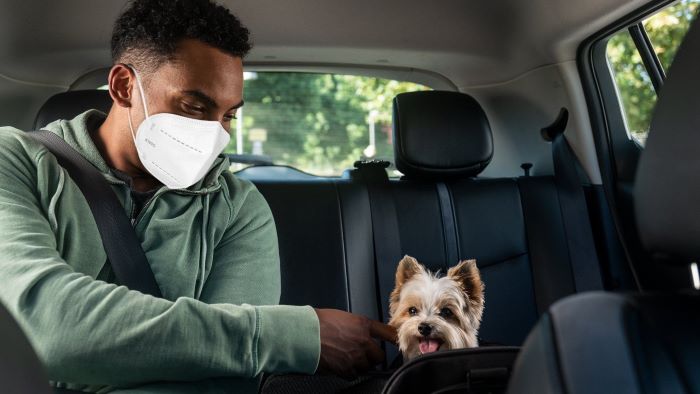
Uber’s Official Policy on Pets
Unlike standard taxi services, Uber allows drivers to make their own rules regarding pets. According to Uber’s website, “Non-service animals are not guaranteed transportation.” The company leaves it up to each independent driver whether or not to permit regular pets in their vehicles. However, under the Americans with Disabilities Act (ADA), service dogs and miniature horses must be accommodated. Refusing a service animal can result in suspension from the Uber platform.
Ultimately, Uber wants to connect drivers willing to transport pets with riders who have them. However, they allow each contractor to decide based on their comfort level, allergies, religious restrictions, or car size. Penalties like cleaning fees are in place for those who try to force pets on non-consenting drivers. Communication and respect on both sides is key.
Driver Attitudes Toward Dogs in Uber
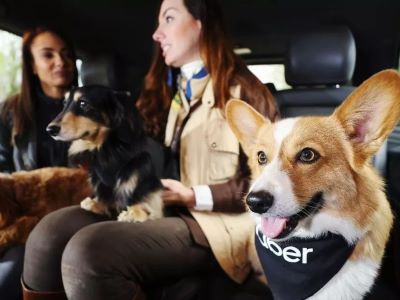
According to driver surveys and reports, most Uber contractors allow riders to bring pets. In a recent poll, around 60% said they were comfortable with dogs and other animals. However, drivers are generally more reluctant to permit larger dog breeds, especially those with negative reputations. There is greater hesitation towards aggressive working breeds like Doberman, or Rottweilers. Most drivers who refuse pets cite concerns about fur, scratches, accidents, and fear.
Small dogs, puppies, and well-trained dogs tend to get the green light. But it’s important, to be honest about your dog’s age, size and temperament when requesting a ride. Travelling during off-peak hours also improves your chances, since drivers have more flexibility when demand is low. Overall, attitude goes a long way – friendly pups accompanied by polite owners encounter fewer issues.
Tips for Travelling with Dogs in Uber
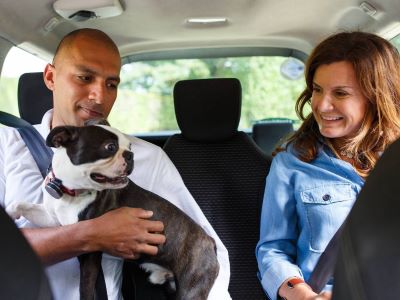
Contact the driver ahead of time: Once matched, call or text to confirm it’s all right to bring your dog. Explain your pet’s characteristics to alleviate any worries. This gives them the chance to cancel if uncomfortable.
Crate or restrain your dog: Even the friendliest pups should be leashed or crated. This keeps both the dog and car safe in case of erratic driving or sudden stops.
Use a blanket or mat: Bring an old sheet or dog bed to put down in the car. This keeps the seats and interior cleaner by controlling hair shedding and muddy paws. Shake it out upon exiting.
Tip your driver: Offer an old sheet or dog bed to put down in the car. This keeps the seats and interior cleaner by controlling hair shedding and muddy paws. Shake it out upon exiting.
Clean up any mess: Carry paper towels or wipes to clean up hair, dirt, or accidents immediately. Apologize sincerely and offer to pay any necessary cleaning fees. Drivers talk, so leaving a mess could blacklist you.
Bring poop bags: You’re responsible for disposing of any waste if your dog relieves themselves during the trip or at pickup or drop-off points. Leaving excrement behind is unacceptable.
Avoid problem behaviours: Barking, grabbing, chewing, aggressive behaviours, and carsickness won’t be tolerated. Your dog may be banned from future rides if they cause disturbances. Keep them calm with toys and gentle handling.
Choose less busy times: Late nights and early mornings tend to be easier for pairing with pet-friendly drivers when demand is low. Similarly, weekdays are less hectic than weekends. Holidays and rush hour and probably out.
Alternatives for Rideshares if No Pets Allowed
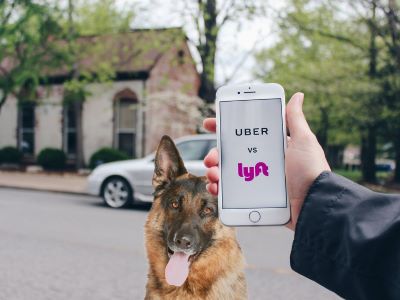
While most rideshares permit service dogs, some drivers refuse to take pets. What alternatives exist for transporting your pets? Here are a few options[1]:
Pet taxi/shuttle services: Some companies specialize solely in animal transport like Pet Taxi. Rates are often higher but pets are guaranteed.
Rental cars: Renting a car gives you full control for road trips or around town with dogs. SUVs and minivans provide space. Consider pet-friendly accommodations.
Traditional taxis: Though declining, old-fashioned taxis may be more lax regarding dogs than Uber or Lyft, depending on the city. Call ahead.
Pet transport services: Private pet shuttle services have sprung up in some cities catering to animal-loving riders. Fares are comparable to rideshares.
Public Transportation: Most buses and subways allow leashed service dogs. Carriers are needed for other pets where allowed.
Dog walking services: Hire a professional walker for short trips. They can be transported while exercising your pooch!
Animal boarding: As a last resort, consider overnight boarding if you’ll need a pet-free rideshare. Retrieve your dog later.
Making Uber Pet-Friendly: Driver and Rider Perspectives
Because Uber classifies drivers as independent contractors, they can make up pet policies on the fly. Many drivers try to find reasonable compromises when approached by riders with dogs. Small fees, pet blankets, and restricting larger dogs are common accommodations. Both sides can rate each other, so cooperation benefits everyone through reciprocal goodwill.
Advocates for more inclusion point to the needs of disabled individuals with service dogs. Other riders argue they should be able to bring well-groomed, non-aggressive pets. With demand growing from pet-loving passengers, Uber has incentives to make ridesharing more dog-friendly. As rating systems collect data, drivers with strict no-pet policies may find themselves passed over for fares. But at the same time, Uber wants to keep contractor drivers happy by allowing them control.
The Future of Pets in Rideshares
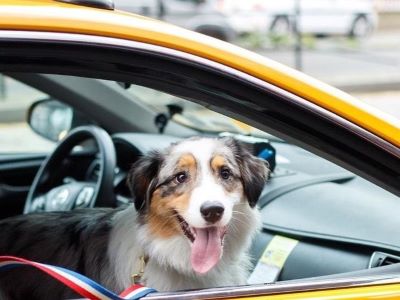
Uber and competitors like Lyft continue to wrestle with setting clear policies around non-service pets. As more people come to rely on rideshares for transportation, allowing dogs provides a competitive edge. But companies also have to balance driver flexibility and realistic constraints around animals in vehicles.
Potential changes that could make rideshares more pet-friendly include:
- Special pet profiles for riders to notify drivers of details like age, size, and temperament.
- Optional certification system for drivers willing to accommodate pets.
- Ability to flag dog-friendly cars for riders with dogs.
- Pet fees or increased fares on rides with animals.
- Driver Incentives like bonuses or higher pay for pet transports
- Enhanced cleaning protocols to mitigate mess or damage
- Wider availability of pet restraints and barriers for vehicles
As autonomous vehicles eventually dominate ridesharing, they could be designed from the group up to be more pet-friendly. Built-in crates, barriers, and easy cleaning options would alleviate many current concerns and restrictions. Until the transition to driverless cars progresses further, clear communication and respecting mutual preferences are key to smooth travels with dogs in Ubers.
FAQs
Can dogs go in Ubers?
Yes, under the Americans with Disabilities Act (ADA), Uber drivers are requested to accommodate service dogs and miniature horses. These working animals must be permitted at all times.
Can I bring my pet dog in an Uber?
Uber’s official policy defers to the driver’s preference when it comes to non-service pets. Many drivers allow dogs, but others may refuse or restrict large breeds. Contact your driver ahead of time to get permission.
What tips should I follow when bringing my dog in an Uber?
Restrain your dog, use a blanket or mat, clean up any messes, avoid problem behaviours like barking or chewing, tip your driver, and contact them beforehand to get approval. Following these tips helps ensure a smooth ride.
Are there any alternatives if Uber drivers refuse my dog?
Yes, optional include pet taxi services, rental cars, traditional taxis, pet transport shuttles, public transportation if allowed, dog walking services, or boarding your dog if necessary. Check local regulations too.
Can I request a pet-friendly Uber?
Not directly, but you can note you have a pet when making the request. Drivers then have the option to accept or deny the ride based on their preferences around dogs.
Conclusion
While rideshare policies are still evolving, most Uber drivers allow dogs and other pets on a case-by-case basis. However, few guarantees exist, so it’s up to the responsible owner to plan their trip accordingly. Contacting the driver ahead of time, restraining your dog appropriately, and cleaning up messes minimize problems. Having reasonable expectations, carrying supplies, and providing tips or extra fees gets your pup passage in all but the strictest cars. With grooming demand from pet-loving passengers, Uber is likely to further accommodate dogs in the years ahead through incentives and partnerships. But for now, a bit of extra planning ensures you and your pet enjoy a smooth ride.
Reference:
- Car Travel With Pets: 10 Tips for Safety and Security | WebMD



